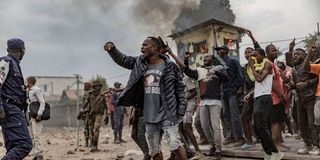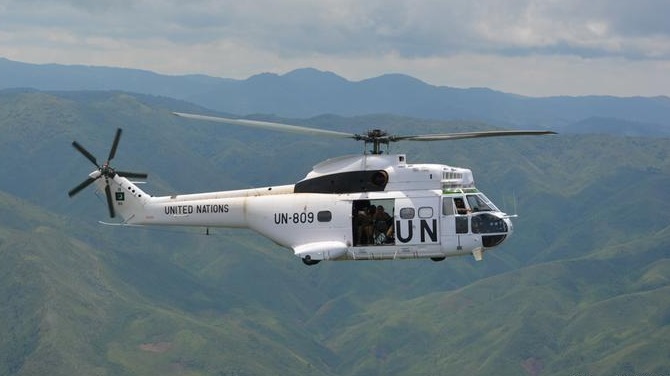Prime
Fresh protests paralyse DR Congo’s Goma over regional Force’s inaction against advancing M23 rebels

Congolese demonstrators gesture during a protest against the UN Peacekeeping mission MUNUSCO in Goma, DRC on July 26, 2022. PHOTO/ AFP
What you need to know:
- The push to have the regional force engage M23 in battle comes barely days after the EAC Heads of State agreed that the situation in Eastern DRC can only be sustainable and resolved through a political process and called for enhanced dialogue amongst all the parties involved.
Fresh protests broke out in Goma, North Kivu province in eastern DR Congo on Monday over alleged inaction by the East African Regional Force amid fears of advancing M23 rebels.
The protestors barricaded roads with stones and paralyzed business in the city of Goma pushing to have the regional force and MONUSCO join the local army, FARDC on the frontline against M23 rebels who they are largely blaming for the conflict in the region.
“From this Monday, February 6, the city of Goma will remain without any activity until Sunday February 12, to demand the recovery of our territories under the occupation by M23 rebels,” a notice for the demos that circulated over the weekend reads.
It adds, “The instructions are clear; the blue helmets of MONUSCO and the soldiers of EAC must join FARDC on all the front lines from this Monday, the EAC and the blue helmets will have to be invisible in the city of Goma.”
The demand aligns with Saturday’s demand by the Ministry of foreign affairs that called on the regional force to engage the rebels in battle.
“The government of the DRC wishes to recall that the mandate of the Regional Force is, unequivocally, offensive according to the letter and the spirit of the communiques of the three Conclaves of Heads of State of the EAC of April and June in Nairobi, as well as the Final Communique of the aforementioned Luanda mini-summit,” the statement reads in part.
The push to have the regional force engage M23 in battle comes barely days after the EAC Heads of State agreed that the situation in Eastern DRC can only be sustainable and resolved through a political process and called for enhanced dialogue amongst all the parties involved.
The Heads of State's call for the immediate ceasefire by all parties was ignored as fighting continued in Ruvunda and Karenga between FARDC and M23 rebels.
EAC Chiefs of Defence Forces are expected to meet this week to set new timelines for the withdrawal of all armed groups and recommend appropriate deployment matrix.
All troop-contributing countries have been directed to immediately deploy their troops to Eastern DRC and DRC urged to facilitate the deployment of troops from South Sudan and Uganda to the regional force.
Last week, Rwandan forces serving under the East African Regional Force (EACRF) were expelled from the force’s headquarters in Goma, as tensions flared following the shooting of a Congolese fighter jet in Goma.
“For security reasons, the DRC has ordered the commander of the Regional Force of EAC to repatriate to their country the officers, Rwandan members of the Force Headquarters based at Goma,” a communique to the Regional Force Commander stated.
The Rwandan forces that left Goma were staffing officers based at EACRF headquarters in Goma who left due to the escalating situation between DRC and Rwanda but no other decision has been made regarding the pull-out of Rwanda from EACRF.
The rest of the Rwandan contingent has been situated at its border with DRC, as with the Burundi, Uganda and South Sudan forces.
Since the start of its mission in November less than 100 days ago, EACRF troops in Goma-mainly consisting of Kenya Defence Forces has managed to stabilize and secure Goma International Airport which was under immense pressure of capture by M23, protected Internally Displaced Persons in Kibumba and Rumagambo and secured other areas that have been vacated by m23 including Kibati, Kibumba and Rumagambo.
They have also opened up the Bunagana-Kiwanja-Rutshuru-Goma route and aided humanitarian assistance through Medicap and escort of humanitarian aid and conducted joint patrols and training with FARDC.
Piling pressure for the force to engage M23 in battle and the fluid security dynamics that led to the killing of a United Nations Peacekeeper from South Africa in an attack on their helicopter on Sunday could lead to a change in strategy in the approach to end conflict in the region.





